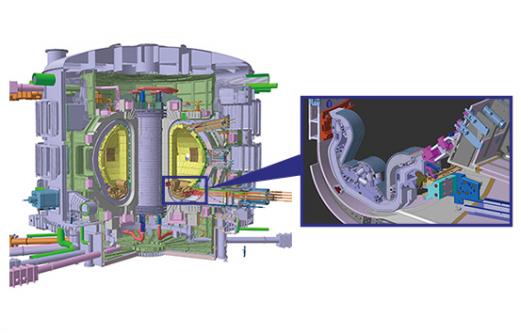
Wisdom and Technology of the World / Brought Together in France
Installing a vacuum chamber (The divertors are installed at the bottom of the chamber.) ©ITER Organization
ITER project, a necessity for nuclear fusion
Nuclear fusion, generating enormous energy with little fuel

Prior to the ITER project, Japan embarked on the development of nuclear fusion in the early 1980s. An experimental nuclear fusion system started operation in 1985. With Europe and the United States, which started development at the same time, Japan has been leading nuclear fusion research in the world. The ITER project was set in motion at the Geneva Summit in 1985, when the idea of the project to demonstrate nuclear fusion for peaceful purposes was proposed by the former Union of Soviet Socialist Republics and the US. The ITER Agreement was officially signed in Paris in 2006 by seven parties: Japan, Europe, USA, Russia, South Korea, China, and India. Currently, a total of 35 countries are participating in the project. The construction of large facilities started in 2007 at Saint-Paullès- Durance in southern France. Key components that were produced by the parties have arrived at the ITER construction site, and the assembly of an experimental fusion reactor ITER, which generates 500 MW of fusion energy, is under-way.
First, let’s define nuclear fusion. The stars in the universe, including the Sun, shine brightly due to the nuclear fusion process, in which lighter nuclei, such as hydrogen, collide with each other and fuse into heavier nuclei, such as helium. A very small loss of mass from the fused atoms releases tremendous amounts of energy in the process. This energy from the Sun flows to the Earth. A huge project aimed at producing fusion energy through this process on Earth is the ITER project.
High safety, virtually inexhaustible fuel resources, environmental friendliness, and enormous amounts of energy
Although they both use nuclear energy, nuclear fusion is totally different from nuclear fission, which is the principle of nuclear power plants. The fusion fuels are isotopes of hydrogen, which can be readily extracted from sea water, and provide a secure and limitless source of energy. Fusion does not emit CO2 and has excellent environmental friendliness. One gram of fission fuel used in nuclear power plants generates energy equivalent to 1.6 tons of oil, whereas 1 g of fusion fuel generates energy equivalent to 8 tons of oil. Nuclear fusion has enormous potential to become the first sustainable energy source for humankind.
Divertor, an essential component for maintaining a plasma state

Since positively charged nuclei have mutual repulsive forces, in order to fuse they need to collide at a speed faster than the speed of sound, and even faster than 1,000 km/s. The method to obtain such speed is to heat deuterium and tritium, isotopes of hydrogen, to a temperature exceeding 100 million degrees Celsius. Under such high temperature, positive ions and electrons are liberated from the nuclei and move in a chaotic way. This is a plasma state in which nuclear fusion occurs. The produced energy then heats other nuclei to more than 100 million degrees Celsius, producing a chain reaction, which requires confinement of plasma at high density for sufficient time within a defined volume. In various methods proposed, an ITER tokamak-type fusion reactor produces strong magnetic fields to confine plasma in a donut-shaped vacuum chamber. At the bottom of the chamber, there is a component for directly receiving high heat flow and particle flow generated by the plasma. This is one of the key components, a divertor. The component discharges helium and impurities produced by the reaction and removes high heat load and particle load for the stable confinement of plasma.
Unbreakable tungsten under high heat load

Designated as Japan’s domestic agency for the ITER project, QST is in charge of manufacturing and delivering commissioned components and equipment to the ITER site, and also serves as Japan’s liaison office for the ITER project. Satoshi Suzuki, Deputy Manager of the Department of ITER Project, Naka Fusion Institute, QST, has been engaged in divertor development for about 30 years.
“The divertor assigned to Japan is called the ‘outer vertical target,’ which is used under severe conditions, such as heat load and particle load from plasma. Since the surface temperature reaches a maximum of 2,300°C, the material is required to have extremely high durability or unbreakability under high heat load. While examining the use of carbon, the ITER Organization determined to use tungsten in 2013. In a high-heat flux test at QST, out of all the materials of domestic and foreign manufacturers, only the tungsten of A. L.M.T. Corp. did not break,” said Suzuki.
What is the genesis of unbreakable tungsten adopted by ITER? The next chapter describes how A.L.M.T. Corp. developed its tungsten.
Registration of public notification
If you register your e-mail address, we will notify you when the latest issue is published. If you wish, please register from the registration form.
To delete your registration, please visit here.
